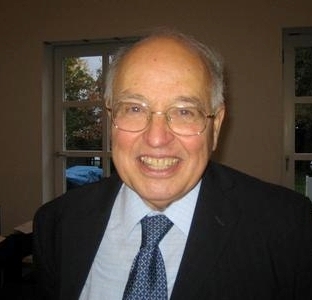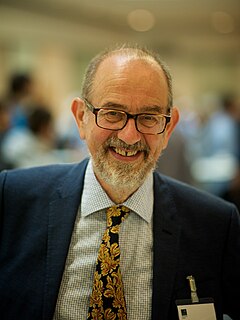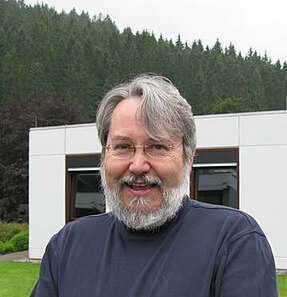Related Research Articles
M-theory is a theory in physics that unifies all consistent versions of superstring theory. Edward Witten first conjectured the existence of such a theory at a string theory conference at the University of Southern California in 1995. Witten's announcement initiated a flurry of research activity known as the second superstring revolution. Prior to Witten's announcement, string theorists had identified five versions of superstring theory. Although these theories initially appeared to be very different, work by many physicists showed that the theories were related in intricate and nontrivial ways. Physicists found that apparently distinct theories could be unified by mathematical transformations called S-duality and T-duality. Witten's conjecture was based in part on the existence of these dualities and in part on the relationship of the string theories to a field theory called eleven-dimensional supergravity.

Sir Michael Francis Atiyah was a British-Lebanese mathematician specialising in geometry. His contributions include the Atiyah–Singer index theorem and co-founding topological K-theory. He was awarded the Fields Medal in 1966 and the Abel Prize in 2004.

Edward Witten is an American mathematical and theoretical physicist. He is a Professor Emeritus in the School of Natural Sciences at the Institute for Advanced Study in Princeton. Witten is a researcher in string theory, quantum gravity, supersymmetric quantum field theories, and other areas of mathematical physics. Witten's work has also significantly impacted pure mathematics. In 1990, he became the first physicist to be awarded a Fields Medal by the International Mathematical Union, for his mathematical insights in physics, such as his 1981 proof of the positive energy theorem in general relativity, and his interpretation of the Jones invariants of knots as Feynman integrals. He is considered the practical founder of M-theory.

In algebraic geometry, a Calabi–Yau manifold, also known as a Calabi–Yau space, is a particular type of manifold which has properties, such as Ricci flatness, yielding applications in theoretical physics. Particularly in superstring theory, the extra dimensions of spacetime are sometimes conjectured to take the form of a 6-dimensional Calabi–Yau manifold, which led to the idea of mirror symmetry. Their name was coined by Candelas et al. (1985), after Eugenio Calabi who first conjectured that such surfaces might exist, and Shing-Tung Yau (1978) who proved the Calabi conjecture.
In theoretical physics, twistor theory was proposed by Roger Penrose in 1967 as a possible path to quantum gravity and has evolved into a branch of theoretical and mathematical physics. Penrose proposed that twistor space should be the basic arena for physics from which space-time itself should emerge. It leads to a powerful set of mathematical tools that have applications to differential and integral geometry, nonlinear differential equations and representation theory and in physics to general relativity and quantum field theory, in particular to scattering amplitudes.
The Chern–Simons theory is a 3-dimensional topological quantum field theory of Schwarz type developed by Edward Witten. It was discovered first by mathematical physicist Albert Schwarz. It is named after mathematicians Shiing-Shen Chern and James Harris Simons, who introduced the Chern–Simons 3-form. In the Chern–Simons theory, the action is proportional to the integral of the Chern–Simons 3-form.
In gauge theory and mathematical physics, a topological quantum field theory is a quantum field theory which computes topological invariants.
In algebraic geometry and theoretical physics, mirror symmetry is a relationship between geometric objects called Calabi–Yau manifolds. The term refers to a situation where two Calabi–Yau manifolds look very different geometrically but are nevertheless equivalent when employed as extra dimensions of string theory.

Nigel James Hitchin FRS is a British mathematician working in the fields of differential geometry, gauge theory, algebraic geometry, and mathematical physics. He is a Professor Emeritus of Mathematics at the University of Oxford.
In theoretical physics, Seiberg–Witten theory is a theory that determines an exact low-energy effective action of a supersymmetric gauge theory—namely the metric of the moduli space of vacua.
In string theory, K-theory classification refers to a conjectured application of K-theory to superstrings, to classify the allowed Ramond–Ramond field strengths as well as the charges of stable D-branes.
In mathematics, and especially gauge theory, Donaldson theory is the study of the topology of smooth 4-manifolds using moduli spaces of anti-self-dual instantons. It was started by Simon Donaldson (1983) who proved Donaldson's theorem restricting the possible quadratic forms on the second cohomology group of a compact simply connected 4-manifold. Important consequences of this theorem include the existence of an Exotic R4 and the failure of the smooth h-cobordism theorem in 4 dimensions. The results of Donaldson theory depend therefore on the manifold having a differential structure, and are largely false for topological 4-manifolds.
In mathematics, and especially gauge theory, Seiberg–Witten invariants are invariants of compact smooth oriented 4-manifolds introduced by Edward Witten (1994), using the Seiberg–Witten theory studied by Nathan Seiberg and Witten during their investigations of Seiberg–Witten gauge theory.
The Geometry Festival is an annual mathematics conference held in the United States.
The Lichnerowicz formula is a fundamental equation in the analysis of spinors on pseudo-Riemannian manifolds. In dimension 4, it forms a piece of Seiberg–Witten theory and other aspects of gauge theory. It is named after noted mathematicians André Lichnerowicz who proved it in 1963, and Roland Weitzenböck. The formula gives a relationship between the Dirac operator and the Laplace–Beltrami operator acting on spinors, in which the scalar curvature appears in a natural way. The result is significant because it provides an interface between results from the study of elliptic partial differential equations, results concerning the scalar curvature, and results on spinors and spin structures.
In mathematics, and especially gauge theory, the Bogomolny equation for magnetic monopoles is the equation
In differential geometry, algebraic geometry, and gauge theory, the Kobayashi–Hitchin correspondence relates stable vector bundles over a complex manifold to Einstein–Hermitian vector bundles. The correspondence is named after Shoshichi Kobayashi and Nigel Hitchin, who independently conjectured in the 1980s that the moduli spaces of stable vector bundles and Einstein–Hermitian vector bundles over a complex manifold were essentially the same.

Claude R. LeBrun is an American mathematician who holds the position of SUNY Distinguished Professor of Mathematics at Stony Brook University. Much of his research concerns the Riemannian geometry of 4-manifolds, or related topics in complex and differential geometry.
In mathematics, and especially differential geometry and mathematical physics, gauge theory is the general study of connections on vector bundles, principal bundles, and fibre bundles. Gauge theory in mathematics should not be confused with the closely related concept of a gauge theory in physics, which is a field theory which admits gauge symmetry. In mathematics theory means a mathematical theory, encapsulating the general study of a collection of concepts or phenomena, whereas in the physical sense a gauge theory is a mathematical model of some natural phenomenon.
In mathematical physics, two-dimensional Yang–Mills theory is the special case of Yang–Mills theory in which the dimension of spacetime is taken to be two. This special case allows for a rigorously defined Yang–Mills measure, meaning that the (Euclidean) path integral can be interpreted as a measure on the set of connections modulo gauge transformations. This situation contrasts with the four-dimensional case, where a rigorous construction of the theory as a measure is currently unknown.
References
- Atiyah, Michael; Witten, Edward (2002), "M-theory dynamics on a manifold of G2 holonomy", Advances in Theoretical and Mathematical Physics, 6 (1): 1–106, arXiv: hep-th/0107177 , Bibcode:2001hep.th....7177A, ISSN 1095-0761
- LeBrun, Claude (1991), "Explicit self-dual metrics on CP2#...#CP2", Journal of Differential Geometry, 34 (1): 223–253, ISSN 0022-040X, MR 1114461